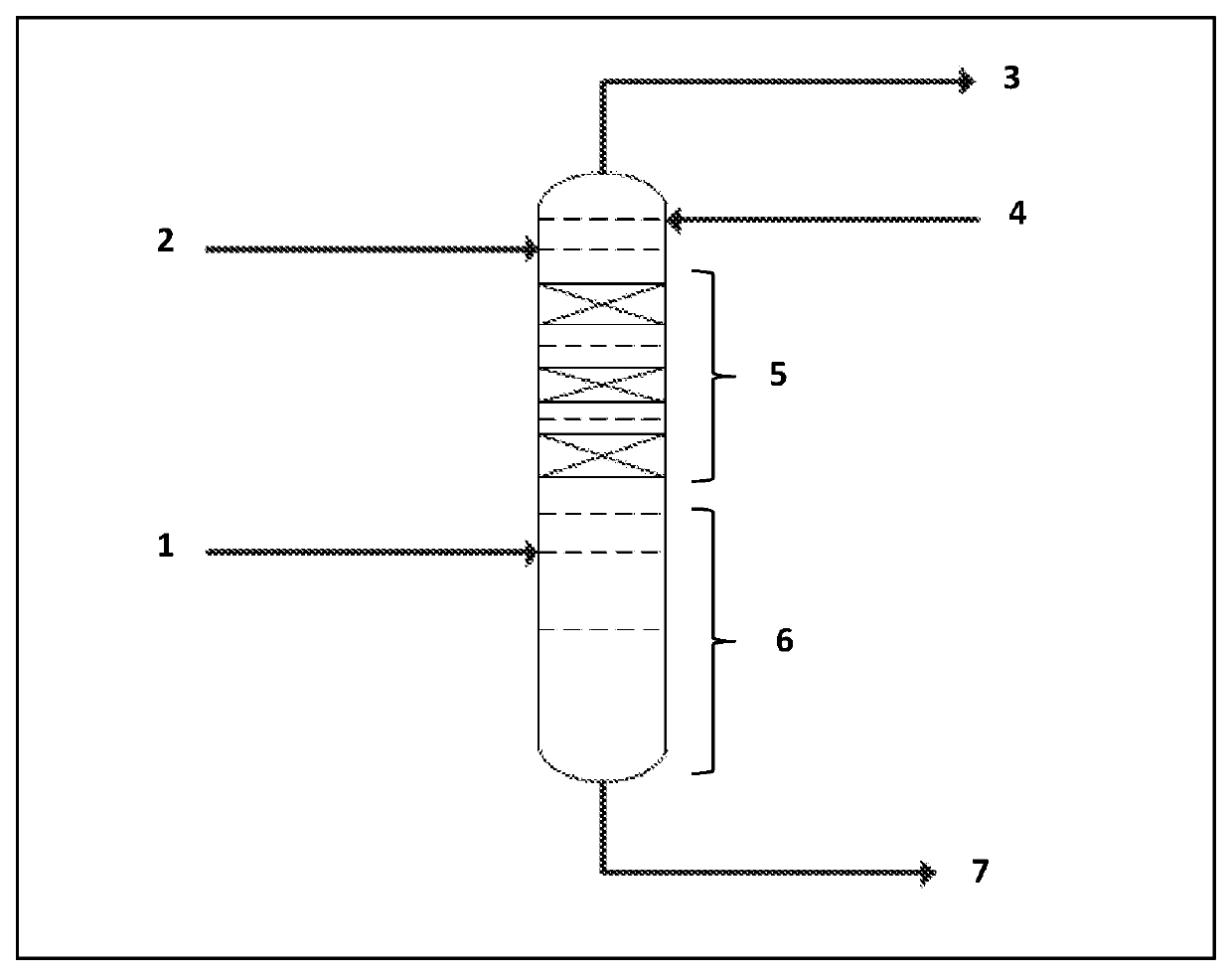Method for separating non-linear olefins from an olefin feed by reactive distillation
a technology of reactive distillation and non-linear olefins, which is applied in the direction of ether preparation, sustainable manufacturing/processing, and separation processes, etc., can solve the problems of no prior quality of isobutene/2-
- Summary
- Abstract
- Description
- Claims
- Application Information
AI Technical Summary
Benefits of technology
Problems solved by technology
Method used
Image
Examples
example 1 (
in Accordance)
[0077]An olefinic feedstock, obtained from the dehydration of isobutanol, comprising 21.8% by weight of isobutene and 2.15% of tertiary branched C5 olefins, feeds, in gaseous form, a reactive distillation column including 42 theoretical plates in total and equipped with a reflux system with a condenser. A stream of ethanol (EtOH) in liquid form is injected into the column in the reflux zone, on theoretical plate 3. The catalyst used is a sulfonic acid resin, Amberlyst® 15, sold by Dow.
[0078]Several tests are performed, varying a few parameters, in particular the localization of the feed on the column and the number of reactive doublets. The column characteristics and the operating conditions are summarized in Table 1.
[0079]Table 1 also relates, for each test performed, the results obtained in terms of content of tertiary branched C4 olefins (i.e. olefins containing 4 carbon atoms, i.e. isobutene) and C5 olefins of the effluent recovered at the top and the total losses ...
example 2 (
not in Accordance)
[0087]Introduction of Ethanol into the Feedstock Upstream of the Column
[0088]An olefinic feedstock, obtained from the dehydration of isobutanol, comprising 21.8% by weight of isobutene and 2.15% by weight of tertiary branched C5 olefins, is treated by means of a process involving a reactive distillation column. A stream of ethanol is introduced into the feedstock upstream of the reactive distillation column. The catalyst used is a sulfonic acid resin, Amberlyst® 15, sold by Dow.
[0089]Table 3 collates the parameters used (column characteristics and operating conditions) and the performance of the reactive distillation section in terms of isobutene content of the olefinic effluent extracted at the top and ethanol losses.
[0090]The content of tertiary branched C4 and C5 olefins in the head effluent is equal to 23.4% by weight. It is thus much higher than the targeted objective (less than or equal to 3% by weight). The ethanol losses are also very high (90.0% by weight)...
example 3 (
not in Accordance)
[0092]Several Relative Column Head Pressures not in Accordance with the Present Invention are Tested.
[0093]An olefinic feedstock, comprising 21.8% by weight of isobutene and 2.15% of tertiary branched C5 olefins, is injected into the reactive distillation column in gaseous form. A stream of ethanol, in liquid form, is introduced into the column at the level of the reflux zone. The catalyst used is a sulfonic acid resin, Amberlyst® 15, sold by Dow.
[0094]Table 4 collates the column characteristics, the operating conditions used and the performance of the reactive distillation section (content of tertiary branched C4 and C5 olefins of the head effluent and ethanol losses).
[0095]
TABLE 4Column characteristics, operating conditions and performance obtained (content of tertiary branched C4 and C5 olefins of the olefinic effluent and ethanol losses)Test aTest b(not in (not in accordance)accordance)Isobutene content of the feedstock21.8%21.8%(weight %)Tertiary branched C5 o...
PUM
| Property | Measurement | Unit |
|---|---|---|
| temperature | aaaaa | aaaaa |
| temperature | aaaaa | aaaaa |
| pressure | aaaaa | aaaaa |
Abstract
Description
Claims
Application Information
 Login to View More
Login to View More - R&D
- Intellectual Property
- Life Sciences
- Materials
- Tech Scout
- Unparalleled Data Quality
- Higher Quality Content
- 60% Fewer Hallucinations
Browse by: Latest US Patents, China's latest patents, Technical Efficacy Thesaurus, Application Domain, Technology Topic, Popular Technical Reports.
© 2025 PatSnap. All rights reserved.Legal|Privacy policy|Modern Slavery Act Transparency Statement|Sitemap|About US| Contact US: help@patsnap.com

